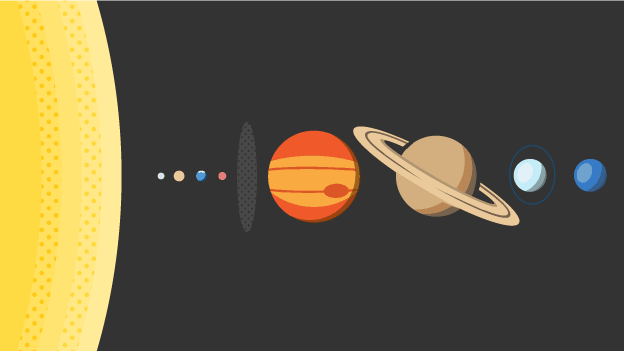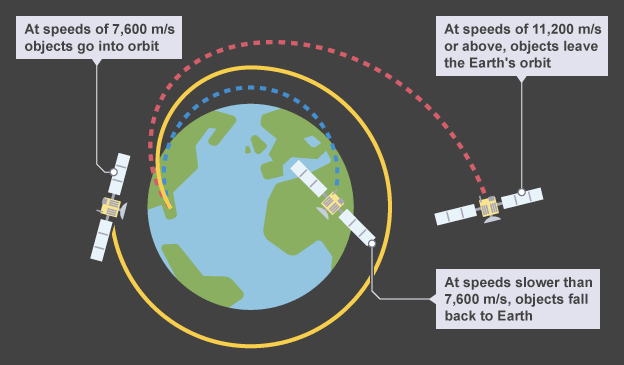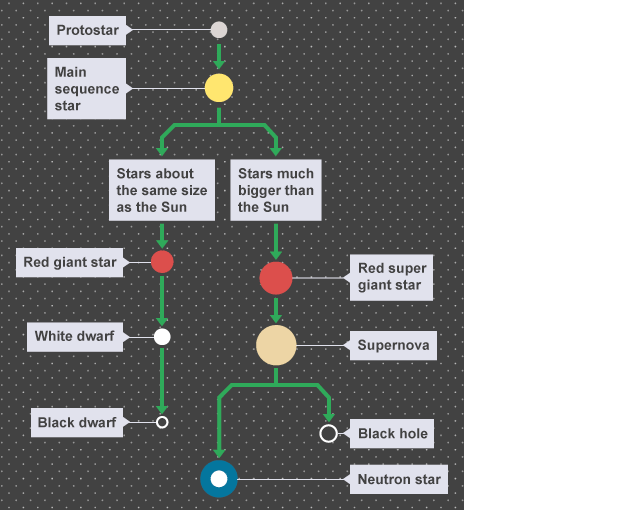Astronomy
The Solar System
The Sun, the Earth's star, is the greatest object in our Solar System. Many additional objects, including planets, dwarf planets, asteroids, and comets, orbit the Sun due to its massive gravitational field.
Structure of the Solar System
Planets
The Earth is one of eight planets in our Solar System. The planets orbit the Sun at varying distances. The eight planets are grouped in order of distance from the sun.

The various planets have unique properties and conditions. In general, when the distance to the Sun increases:
the temperature decreases, for example, Mercury is 430°C and Neptune is -200°C
Mercury rounds the Sun every 88 Earth days, whereas Neptune revolves every 165 Earth years.
A planet must have enough gravity to generate a round or spherical shape. Its gravitational field must also be powerful enough to 'clean the neighborhood', attracting smaller surrounding objects into its orbit.
Moons
Moons are natural satellites that circle their planet.
Many planets have moons, and some have many of them, such as Saturn, which has over 50.
The Earth has only one moon, the Moon.
Dwarf planets
Pluto is a dwarf planet. A dwarf planet's gravitational field is insufficient to clear the surrounding area, therefore other objects may be orbiting the Sun.
The Solar System is home to hundreds of dwarf planets, including Ceres (the only dwarf planet in the asteroid belt).
Asteroids
The Solar System contains smaller objects known as asteroids.
These orbit the Sun in very elliptical orbits that are oval or egg-shaped and can take millions of years to complete.
Asteroids are composed of metals and stony materials.
A huge number of asteroids orbit the Sun in the asteroid belt between Mars and Jupiter. There are also more in the Kuiper Belt, which extends beyond Neptune.
Comets
Comets are tiny, celestial objects found in the Solar System.
Comets are similar to asteroids, but are composed of stony material, dust, and ice.
As a comet approaches the Sun, it evaporates, transforming into a gas. It subsequently develops a characteristic tail.
Weight, mass, and the gravitational field strength
The weight of an object is the force exerted by the planetary gravity. The weight of an object is the gravitational field strength is directly proportional.
For a particular mass, the planet's gravitational field strength determines its weight.
Weight can be determined using the following equation:
Weight = mass x gravitational field strength
Here's when:
Weight (W) is measured in newtons (N).
The mass (m) is measured in kilograms (kg).
The gravitational field strength (g) is measured in newtons per kilogram (N/kg).
Gravity on other objects in space
Space object | g, gravitational field strength (N/kg) |
|---|---|
The Sun (star) | 293.0 |
Mercury | 3.7 |
Venus | 8.8 |
Earth | 9.8 |
Moon (satellite) | 1.7 |
Mars | 3.7 |
Ceres (dwarf planet) | 0.27 |
Jupiter | 24.7 |
Saturn | 10.5 |
Uranus | 9.0 |
Neptune | 11.7 |
Changing concepts about the Solar System
The way humans believe about the Solar System has altered numerous times throughout history.
Prior to the invention of the telescope, these concepts were based on what could be seen with the naked eye. This limited the amount of information that could be gathered about the Solar System because asteroids, most of the satellites of other planets, and the most distant planets are not visible to the naked eye.
Ptolemy (AD100-168)
An Egyptian astronomer who gave one of the earliest concepts about the organization of the Solar System.
Ptolemy's concept, as well as many prior ideas about the Solar System, placed the Earth in its center.
As observations of the planets' motions became more detailed, explanations of the Solar System had to become increasingly complex in order to retain the Earth at the center.
Putting the Sun in the Center
Nicolas Copernicus (1473-1543) is often credited with shifting the model of the Solar System to one with the Sun at its center. Detailed observations using telescopes have confirmed that this is the correct idea.
Orbital motion
Gravity provides the force required to maintain the steady orbit of planets around stars, as well as moons and artificial satellites around planets.
Explaining Orbits
To maintain a constant, circular orbit, an object must travel at the appropriate speed. The diagram depicts a satellite orbiting Earth.
There are three potential outcomes:
If the satellite moves too quickly, the gravitational attraction between Earth and the satellite is insufficient to keep it in orbit. If this is the case, the spacecraft will take off into space. This occurs at speeds approaching or above 11,200 meters per second (m/s).
If the satellite moves too slowly, the gravitational attraction is too great, and it will plummet towards Earth. This occurs at speeds of around or below 7600 m/s.
A stable orbit is one in which the satellite's speed is just correct; it will neither drift into space or spiral into the Earth, but will follow a defined course.

Orbits and Constant Speed
When an object goes in a circle at a constant speed, its direction changes continuously.
A change in direction results in a change in velocity. This is because velocity is a vector quantity, which means it has both a direction and a magnitude.
A change in velocity causes acceleration, so an object moving in a circle is accelerating even while its speed remains constant.
An object will only accelerate if a resulting force acts on it. For an item moving in a circle, the centripetal force operates toward the center of the circle.
Gravitational attraction provides the centripetal force required to maintain planets and all forms of satellites in orbit.
Orbits and shifting speeds
The gravitational pull of two objects decreases with distance. This indicates that the gravitational pull between two things increases as they go closer together. If the force between them is stronger, the acceleration will increase.
The greater the acceleration, the greater the change in velocity; thus, the item moves quicker. This means that objects in narrow orbits move quicker than those in larger orbits. To maintain a stable orbit, an object must adjust its orbital speed while also changing its orbital radius.
Artificial satellites go in one of two possible orbits:
Polar orbits
Geostationary orbits
Polar orbits carry satellites across the Earth's poles. Satellites travel at great speeds (almost 8,000 m/s) because they are so close to the Earth (as low as 200 km above sea level).
Geostationary satellites orbit the Earth every 24 hours, thus when viewed from the ground, they appear to be in the same portion of the sky. These orbits are substantially higher than polar orbits (usually 36,000 km), therefore satellites travel at a slower rate (approximately 3 km/s).
Red shift
A star's light does not comprise all of its wavelengths of the electromagnetic spectrum.
Elements in the star absorb part of the emission wavelengths, resulting in dark lines when the spectrum is examined.
Different ingredients generate distinct patterns of black lines. The graphic depicts part of the Sun's radiation spectrum.
Spectra of distant galaxies
Astronomers can observe light from distant galaxies. When they do this, they notice that the light is different from that of the Sun. The dark lines in the spectra of distant galaxies show an increase in wavelength but a drop in frequency.
The lines are skewed towards the red end of the spectrum. This effect is known as red shift.
Red shift and speed
Astronomers observe red shifts in almost all galaxies. It occurs as the gap between the Earth and the galaxies expands.
This expansion expands the light waves as they travel to us, moving them towards the red end of the spectrum.
The more red-shifted a galaxy's light is, the quicker it moves away from Earth.
Theories about the Universe
Big Bang Theory
The Big Bang theory suggests that approximately 13.8 billion years ago, the universe was a small, hot, and dense place. From this little point, the entire Universe spread outwards to what we see today.
Evidence from Red Shift
Astronomers observed that, in general, the farther away a galaxy is, the more red shifted its light is. This indicates that galaxies move faster as they get further away.
This is akin to an explosion in which the fastest moving bits travel the furthest away from the explosion.
Red shift data indicates that the universe, including space itself, is expanding.
Evidence from CMBR
Astronomers also identified the cosmic microwave background radiation (CMBR). This emanates from all directions in space and has a temperature of approximately -270° Celsius.
The CMBR is the remaining thermal energy from the Big Bang, which is dispersed thinly over the Universe.
The finding of the CMBR, which had been predicted by the hypothesis, offered substantial support for the Big Bang theory, resulting in the Big Bang becoming the currently accepted model of the Universe's creation.
The Steady State Theory
Another view about the Universe, known as the Steady State theory, states that it has always existed and is constantly expanding, producing matter as it does so. The CMBR does not support this theory, but the red shift evidence does.
Following the discovery of the CMBR, the Steady State theory lost favor and is no longer considered plausible.
The Observable Universe
Humans' perspectives on the universe have evolved over time. Initially, the only information provided was that which could be seen with the naked eye.
The advent of the telescope allowed for considerably more detailed observations, as well as the ability to see objects far away. Modern advances in telescope size and sensitivity have enabled observations at amazing distances and even the faintest stars.
Invisible observations
Modern equipment can be made sensitive to electromagnetic frequencies that human vision cannot detect. This has opened up new fields of astronomy.
Observing radio waves, infrared, and X-ray emissions from stars and galaxies has enabled scientists to make a plethora of discoveries in a relatively short period.
Space telescopes
Many of the extra wavelengths of electromagnetic waves that astronomers wish to investigate do not penetrate the atmosphere. This means that any telescope designed to use these sections of the electromagnetic spectrum, such as most ultraviolet light, must be mounted on a satellite above the atmosphere.
The Hubble Space Telescope features detectors for visible light, infrared, and ultraviolet.
The Sun
The Solar System began approximately 4.6 billion years ago from a huge cloud of dust and gas known as a nebula. This collapsed under its own gravity, converting gravitational potential energy into kinetic energy in its components.
As the nebula collapsed, it grew denser and rotated faster. Particle collisions resulted in the transfer of kinetic energy as both internal and thermal energy.
The nebula's core began to develop into a hot, dense protostar. When the Sun's core got hot and dense enough, nuclear fusion reactions occurred, releasing energy and radiation.
A star like the Sun is in equilibrium; gravity pulls it inwards, while radiation pressure from nuclear reactions expands it outwards. In other words, the gravitational collapse is offset by the expansion caused by fusion energy.
The Sun is currently a main sequence star, and it will remain so for another 4-5 billion years. It will then expand and cool, becoming a red giant, before shrinking and heating up again to become a white dwarf. The white dwarf star will run out of nuclear fuel and gradually cool down over billions of years.
The life cycle of stars
The life cycle of a star varies according to its size. The graphic depicts the life cycles of stars which are:
Approximately the same size as the Sun (left hand route)
much larger than the Sun in size (right-hand route)

Every star begins life in the same way. A cloud of dust and gas, also known as a nebula, develops into a protostar, which eventually becomes a main sequence star. Following that, stars evolve in various ways based on their size.
Stars with significantly higher mass than the Sun take the appropriate path: red supergiant star → supernova → neutron star or black hole (depending on size).
Nebula
A nebula, or vast clouds of dust and gas in space, is where a star forms.
Nebulae are primarily made of hydrogen. Gravity starts to drag the dust and gas together.
Protostar
As the mass falls together, it becomes heated. When the temperature is high enough, hydrogen nuclei fuse together to produce helium, forming a star. The fusion process releases energy, keeping the star's core heated.
Main Sequence Star
During this steady phase of a star's life, the force of gravity that holds it together is balanced by higher pressure caused by high temperatures. The Sun is currently in a steady period of its life.
Red giant star
When all of the hydrogen has been used up in the fusion process, bigger nuclei begin to develop, and the star may expand into a red giant.
White dwarf
When all of the nuclear processes are completed, a tiny star, such as the Sun, may begin to compress due to gravity. In this case, the star becomes a white dwarf, fading and changing color as it cools.
Supernova
A larger star with more mass will continue to produce nuclear reactions, becoming hotter and expanding until it explodes as a supernova. An exploding supernova emits hot gas into space.
Neutron stars or black holes
A supernova will leave behind either a neutron star or a black hole, depending on its initial mass.
 Knowt
Knowt
